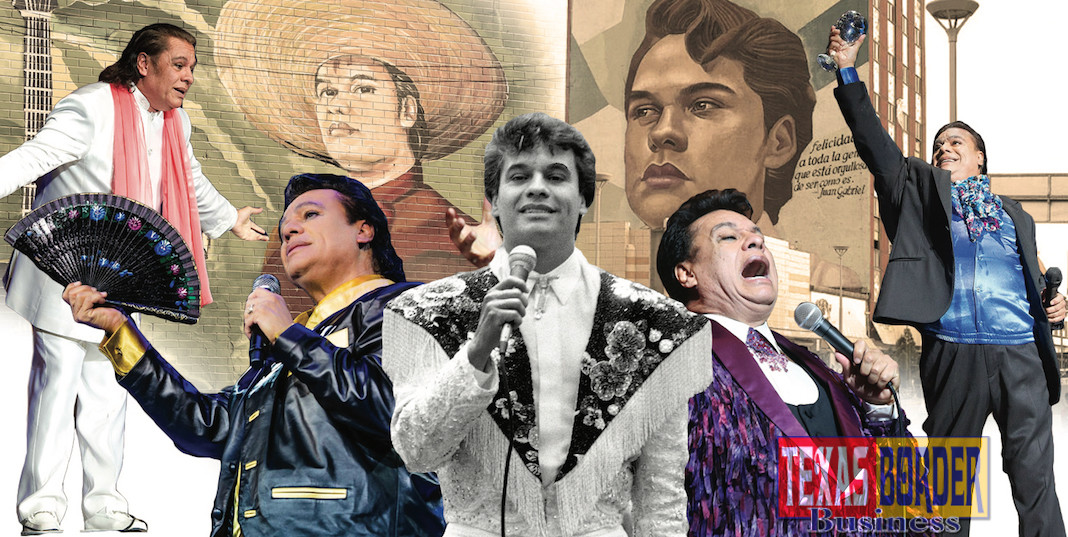By Dr. María Teresa Vázquez Castillo,
As originally published by Texas Border Business newsprint edition October 2016.
The impact of Juan Gabriel’s death all over Mexico and in Latin America has been widespread. I will attempt to briefly recollect my impressions of this event from the once called “most dangerous city in the world”: Ciudad Juárez. One of my colleagues and I were driving along on our way to have lunch, when I received via text message the unexpected news about the death of Mexican pop singer Juan Gabriel; it was Sunday afternoon on August 28. Once at the restaurant, the TV screens were showing video clips of his singing and his life. People in the restaurant looked sad and somber, commenting about the recent news. After lunch, while going back to downtown, we found that Avenida 16 de Septiembre had been closed to traffic.
A couple of hours after his death, Juan Gabriel fans were taking over this main avenue where his home is located. Juarenses know that he had bought that house as a gift for his mother, who used to work as a domestic worker in the area.
As traffic police had closed Avenida 16 de Septiembre, we, as many other people, parked nearby and walked to Juan Gabriel’s house. People were already gathering in front of his house, carrying flowers and posters, photographs and records, speakers and karaokes. All generations were there: grandmothers, children, young couples with their babies, and adolescents, all of them singing at once; some of them with tears in their eyes, “Como quisiera que tú vivieras, que tus ojitos jamás se hubieran cerrado nunca y estar mirándolos. Amor eterno e inolvidable…” How I wish that you lived, that your little eyes would have never closed, and to look at them. Eternal and unforgettable love”
But then, they continued on a more joyful way, waving arms and hands, singing: “¿Quieres bailar esta noche? Vamos al Noa, Noa, Noa, Noa, Noa, Noa, Noa, ¡vamos a bailar!” Do you want to dance tonight? Let’s go to the Noa, Noa, Noa, Noa, Noa, Noa, Noa. Let’s go to dance!
He had written the first song, Amor Eterno, in memory of his mother and the second one in homage to the Noa Noa nightclub, located in downtown, on Avenida Juárez, the place where he initiated his career. In 2004, a fire destroyed the Noa Noa and currently the site houses a parking lot. Although his handprints and a star with his name had been placed in a small concrete platform in front of the extinct Noa Noa, newer generations do not know that this location was the inspiration for the famous Noa Noa song. Rather, in 2015, during the renovation of Avenida Juárez, some construction workers almost demolished the platform that contains the handprints of Juan Gabriel because of “municipal orders to clear up the avenue,” they said. Juan Gabriel had played an active role as a civic leader in Ciudad Juárez. In 1987, he established a music school and children’s shelter called Semjase, also located in downtown, which served low-income children for almost 28 years before closing in 2015.
Additionally, he offered free benefit concerts to attend community needs. In order to contribute to the revitalization of the city, there were plans to transform his house into the Juan Gabriel Museum and to rebuild the Noa Noa nightclub. These latter works were not initiated during his lifetime. However, once the news of his death was announced, the City Council approved naming Gran Plaza Juan Gabriel, the new plaza built on the Mariscal Street, which was part of the urban renewal of the historic downtown core.Because of his community engagement, added to his artistic trajectory, Juan Gabriel was considered one of the favorite sons of Ciudad Juárez. In his concerts, he would exclaim: Arriba Juarez!
His death caused an unprecedented impact that took masses of people out in the streets and into downtown Ciudad Juárez, from the day he died, continuously, until the day of his funeral. The city had to close Avenida 16 de Septiembre for the entire week, so that people could gather safely in front of his house. And every single day and night, from August 28 to September 3, Juarenses took turns singing in front of his house and to offer flowers as a tribute and as a goodbye. It was a public funeral that lasted for a week, even when Juan Gabriel’s ashes were not even present in town yet.
“He was from Juárez, because it was here that he started his career”, people claimed, and they paid homage not only by keeping daily presence in front of his house on Avenida 16 de Septiembre, but also next to his handprints in front of the Noa Noa on Avenida Juárez, and next to his mural, also on Avenida Juárez and painted just last year.
A week later, on September 3 at 6:00 PM, his ashes arrived to the city via El Paso. And as a taste of the binational nature of the border region, the bishops of Ciudad Juárez and of El Paso, Texas celebrated a memorial mass outside his house, which thousands of people from all social sectors attended, taking back, once again, downtown. It was almost 10:00 PM when the mass was over. Many people left, while many others remained for the memorial concert that included a famous band and other musicians. Those leaving the event merged into rivers of people that inundated the Avenida 16 de Septiembre. Because of the period of violence that the city had faced, people had abandoned the streets and walking at night was not advisable.
But on that day, families with children, young women, elderly people, adolescents, and gay couples holding hands paying tribute to a comrade were walking up and down the Avenida. The sounds of the song “La Frontera” playing somewhere made me consider if it was true that the scars that the violence left were a thing of the past.
“Aquí todo es diferente en la frontera, a mí me gusta mucho estar aquí.
¡Arriba Juárez, arriba tú!… El pasado nos dejó cicatrices. Gracias a Dios ahora todos somos felices.” Here in the border, everything is different. I like very much, to be here.
Up with Juárez, Up with you… The past left us scars. Thanks to God now, all of us are happy”
The International Paso del Norte or Santa Fe Bridge, connecting Ciudad Juárez and El Paso, Texas, was packed with people returning from the memorial mass for Juan Gabriel. Paseños and New Mexicans dared to visit Juárez at night in spite of the scars of fear that the extreme violence had left in people’s memories. Who would have thought that Juan Gabriel was capable of making fronterizos on both sides of the border again take the city streets at night, walk them, stroll them; in sum, re-appropriating downtown? As one lady walking to my side joyfully said, “Today is like Juárez used to be.” Unfortunately, violence has increased during the past two months once again. Who knows what will happen in the city? But Juan Gabriel made us take back that night and downtown Ciudad Juárez for an entire week.
Written by María Teresa Vázquez Castillo, she is a professor and researcher in the Department of Architecture at the Autonomous University of Ciudad Juarez. TBB





















